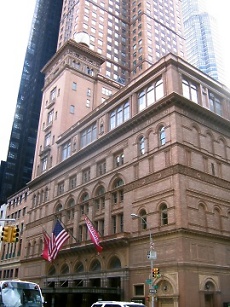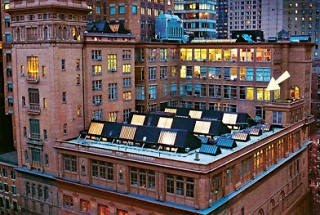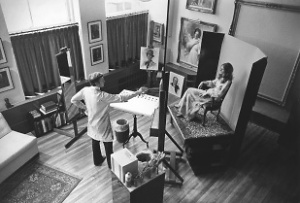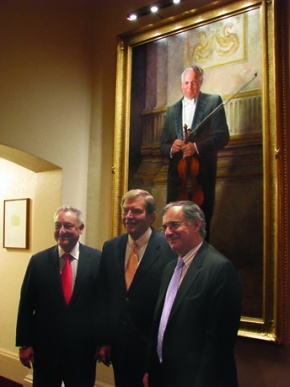33
Years in Carnegie Hall
For More Than
a Century, the Studios of
Carnegie Hall Were a Focus of Creativity in the
Art World of New York City. In 2008, They Closed
Forever, Leaving Rich Memories Behind...
| |

Andrew
Carnegie's vision was to create, at this
location, in addition to the world-famous
concert hall, a multi-arts complex in which
all of the arts could flourish. |
In 1890, the steel magnate Andrew Carnegie
opened what was to be quickly recognized as
the greatest concert hall in the world in the
new building he had constructed on Manhattan's
West Fifty-Seventh Street. Carnegie's "Music
Hall" (those words still appear above the
main entrance marquee) was seen as the most
desirable performance venue in existence (121
years later, this assessment of the Music Hall's
prestige is more firmly established than ever.)
Complete as this success was, it did not satisfy
the great philanthropist. Before the first concert
season was over, Andrew Carnegie realized that
to make the venture sustainable, additional
income would be required. He envisioned an added
complex of rental apartments and studios beside,
behind and on top of the performance hall.
To accomplish this, Carnegie called in one
of the foremost architects of the day, Henry
J. Hardenburgh, whose accomplishments in New
York included the Plaza Hotel, the Dakota Apartments
on Central Park West, and the Art Students League
building diagonally across Fifty-Seventh Street.
Together, Carnegie and Hardenburgh fashioned
a unique multi-arts environment in two dramatic
towers rising on either side and above the original
building.
There were around 170 separate spaces in all,
varying in size from huge dance and rehearsal
studios to high-ceilinged painter's studios
(with the best natural north light in New York),
to smaller spaces suitable for writers and musicians.
The new studio additions opened in 1894, and
were an immediate hit with the artistic community.
The studios filled up at once with a lively
mix of painters, dancers, writers, musicians
and actors.

Andrew
Carnegie and his architect, Henry Hardenburgh,
added two towers of studios, surrounding
the original concert hall. These 170 spaces,
of varying sizes, included the very best
north-light painting studios in New York.
My first studio, 1011, is marked with an
arrow. Photograph by Joseph Astor.
|
|
Thus Carnegie Hall took on the character of
a richly-textured artistic community which facilitated
creative pursuits in all the arts—a tradition
that survived in a vibrant fashion into the
twenty-first century, adding immeasurably to
the cultural richness of New York.
My own experience with Carnegie Hall began in
1975, when my wife Elizabeth and I leased studio
1011 on the tenth floor of the South Studio
Tower. It was a marvelous, high-ceilinged room,
with stunning views of Central Park to the north,
and the Hudson River to the west. It was the
very best painting studio of my entire career.
For a portrait artist, it was the very best
location in the city. For Elizabeth and me,
it was ideal in every way. I was teaching several
evenings a week at the Art Students League (across
the street, and just up the block). Our home
was one-half short block away, in the Alwyn
Court Apartments at 58th and Seventh Avenue.
Our church was just a few blocks to the east.
Our daughter's school was a short bicycle ride
to the East Side.
| |

My
wife Elizabeth and I (here I am painting
her portrait) leased Studio 1011 in the
South Tower of Carnegie Hall in 1975. It
was a marvelous, high-ceilinged room, with
stunning views of Central Park to the north,
and the Hudson River to the west. |
We were entranced by the ambience of the Studios
environment. Immediately across the hall was
the family home of the well-known New York fashion
designer Bert Geiger. Among our other neighbors
on the tenth floor were the internationally
acclaimed photographer David Hamilton (famed
for his volumes of poetic photos of young girls),
popular voice coach Silas Engum, and Professor
Rudolph Schramm, a radio pioneer, co-founder
of the National Symphony Orchestra, and the
director of President Franklin Roosevelt's famous
radio "fireside chats." It was an
incredibly rich creative atmosphere.
The other floors were equally packed with diverse
artistic talents. A daily treat was encountering
New York Times fashion photographer Bill Cunningham
coming down in the elevator with his bicycle
from his twelfth floor studio. Editta Sherman,
photographer of celebrities was midway through
her sixty-year reign as the "Duchess of
Carnegie Hall."

Bill Cunningham |
|

Editta Sherman |
|
My clients and subjects enjoyed coming to Carnegie
Hall. The location was convenient to the great
hotels of midtown, and it was an easy address
to give to a taxicab driver. Hundreds of sitters
came to Studio 10ll, and later Studio 1010,
among them evangelist Billy Graham, presidential
advisor Clark Clifford, Treasury Secretary Paul
O'Neill, Defense Secretary Richard Schlesinger,
Mrs. Nelson Rockefeller and publisher Henry
Luce. In the Carnegie studio, I painted the
leaders of the five greatest banks in America:
David Rockefeller of Chase Manhattan, Hugh McColl
of Bank of America, Sanford Weill of Citigroup,
William Harrison of J.P. Morgan Chase, and John
Medlin of Wachovia.
| |

As
a token of appreciation to Carnegie Hall
for the benefits of working within its walls
for more than three decades, I painted this
portrait of the man who saved Carnegie Hall
from demolition in the 1960's: violinist
Isaac Stern. Here I'm posing with the Chairman
of Carnegie Hall, Sanford Weill, and the
Artistic and Executive Director, Sir Clive
Gillinson. Click
here to view the complete painting. |
The loss of our Carnegie Hall studio, in 2008,
was painful for me and for my family (my children
had never known a time when Carnegie was not
the geographical and logistic focus of our life
as a family). Since the Carnegie closing, I
have held my sittings and meetings with clients
in the luxurious accommodations of the New York
Athletic Club, just two blocks away on Central
Park South (click
here to see our new arrangements).
We elected to not fight our expulsion from Carnegie
Hall, partly out of admiration for the Hall's
leaders, Sandy Weill and Clive Gillinson (see
the photo at the right), and partly out of gratitude
for having been privileged to work—for
more than three decades— in so glamorous
and stimulating an environment.
As this is being written, a vast and dramatic
renovation of the empty studios is under way,
and a breathtaking new environment is being
created, dedicated to music education.

|